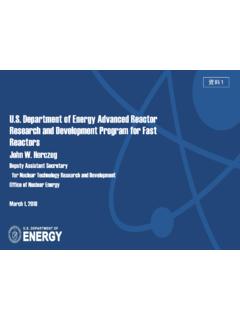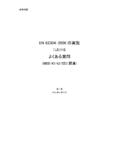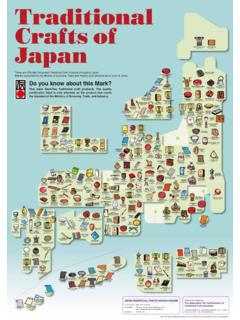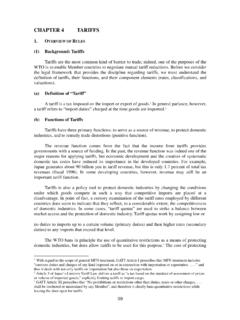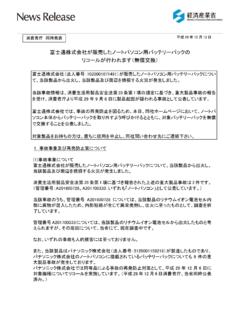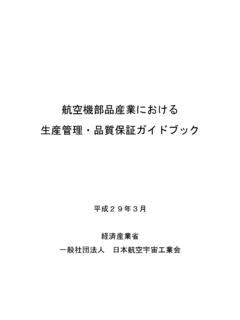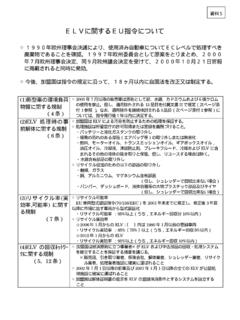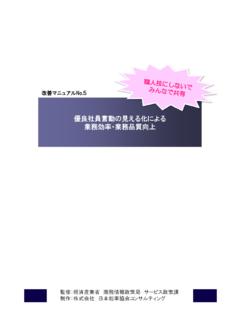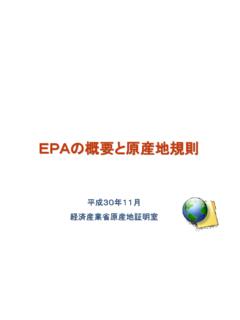Transcription of Strategy for LNG Market Development
1 Strategy for LNG Market Development Creating flexible LNG Market and Developing an LNG Trading Hub in Japan May 2, 2016. Ministry of Economy, Trade and Industry Government of Japan -1- 1. Introduction Liquefied natural gas (LNG) is a significant traded commodity with the second largest annual trade value of more than 150 billion dollars, following that of crude oil. Tokyo Gas Company and Tokyo Electric Power Company first started importing LNG from Alaska in 1969, and Japanese utility companies have led the Development of an LNG Market around the world. Japan is now the world's largest consumer of LNG, importing approximately 89.
2 Million tons (approximately one-third of the total demand of the whole world in 2014). In addition to Japan, LNG imports have expanded to Korea, China, and other countries. Based on the Strategic Energy Plan (Cabinet Decision on April 11, 2014), which positions natural gas as a significant energy source whose role is expected to expand into the future, the Long-term Energy Supply and Demand Outlook ( Energy Mix ) was compiled in July 2015. The outlook forecasts that the import volume of LNG will be maintained at the level of around 62 million tons in 2030. LNG is thus continuously positioned as a strategically important resource for Japan.
3 Following the shale revolution and the reform of the electricity and gas markets in Japan, the Market environment surrounding LNG is now experiencing drastic changes, and the focus in securing a stable energy supply under normal condition needs to be shifted from securing long-term stability and sufficient quantity to securing flexibility and resiliency and better Market utilization. The Ministry of Economy, Trade and Industry ( METI ) has held dialogues with major consumers and suppliers of LNG since last November, in collaboration with the Ministry of Land, Infrastructure, Transport and Tourism and relevant organizations (JOGMEC 1, JBIC 2, NEXI 3, Tokyo Commodity Exchange ( TOCOM ), etc.)
4 In light of the information obtained through such dialogues and utilizing this time of drastic changes as a good opportunity for Japan, the world's largest consumer of LNG, to play an initiator role in creating a global LNG. Market , METI decided to compile this Strategy . We hope that related parties both in the private and public sectors share the vision indicated in this Strategy and accelerate respective efforts to take necessary actions. 2. Recent fundamental changes in the LNG Market (1) The shale revolution and LNG exports from the The shale revolution in the beginning in the 2000s has changed energy supply 1 Japan Oil, Gas and Metals National Corporation 2 Japan Bank for International Cooperation 3 Nippon Export and Investment Insurance -2- dramatically and thus affected the global energy and supply environment.
5 The continuous innovation in shale technology reduces the costs of drilling and production dramatically and it is expected that gas prices in the will continue to be lower than oil prices. The export of the first LNG from the mainland in February 2016 was a key indicator that the shale revolution will affect the gas Market worldwide. It is better for Japan to benefit from the decoupling of oil prices and gas prices by optimizing LNG transactions. (2) Growth in global LNG demand Global LNG demand is expected to increase by around 45% from the current 250 million tons to reach close to 350 million tons by 2020.
6 4 It is expected that the LNG demand especially in China and India will continue to grow, and the traditional LNG exporting countries such as Malaysia and Indonesia will turn into LNG importing countries. This trend clearly shows that the Asian countries will be a driver for the rapid LNG growth worldwide. In Europe, the role of LNG has been reassessed and the use of LNG is likely to increase from the supply security perspective. Additionally, it is also expected that the LNG demand will grow in other regions such as the Middle East and South America. Furthermore, at COP21 (the 21st session of the Conference of the Parties to the United Nations Framework Convention on Climate Change) held at the end of last year, the Paris Agreement was signed to oblige all participating countries to submit their Nationally Determined Contributions ( NDCs ) to reducing greenhouse gas emissions.
7 As the need to address global warming attracts more people's attention, natural gas, which emits less CO2. than coal or oil, is expected to play an increasingly significant role. (3) Systematic changes in global LNG supply The role of South East Asia and the Middle East is significant in terms of LNG supply. The role of those areas will continue to be significant, but the overall amount of LNG exports is expected to decrease compared to the current level. On the other hand, large scale LNG. projects are scheduled to commence in the United States and Australia in several years and a large volume of LNG will be supplied to the Market .
8 More of the players in those countries are private rather than state-owned, so they will be more Market -oriented, with more impacts on the LNG Market globally, and the trend is likely to create more room for LNG importers to import LNG in a more flexible manner. 4. Source: International Energy Agency (IEA). -3- (4) Enhancement of Market -oriented behaviors of Japanese LNG buyers due to the liberalization of electricity and gas markets Full liberalization of the electricity Market commenced in April 2016 and full liberalization of the gas Market , scheduled for April 2017, will bring about drastic changes in the behavior of Japanese electricity and gas companies, which are the world largest LNG consumers.
9 Specifically, due to the unclear energy demand forecasts, LNG purchasers will seek more flexible and diverse options (in terms of regions, procurement periods, price formulae, etc.). Additionally, expanding the introduction of renewable energy will further increase uncertainty in LNG demand for electricity. In liberalized electricity and gas markets, procurement costs for LNG directly affect the competitiveness of those companies. To adapt to such changes, Japanese companies will attempt to leverage a flexible Market as means for optimizing and hedging quantities and prices of their LNG portfolio. In the near term, there may be more cases where some purchasers that have surpluses under long-term contracts become spot sellers both within Japan and overseas.
10 As a result, it has become highly likely that a new procurement model will become widely adopted, combining a new manner of procurement where diverse players make short-term or spot purchases of LNG in the Market , even though the significance of the conventional procurement model in which purchasers conclude a long-term contract for each project cannot be denied for the time being. Changes in the procurement models used by Japanese companies may be a key driver to change in the worldwide LNG Market . (5) Worldwide trend in integration of natural gas markets Natural gas markets are divided into the European Market and North American Market , both of which are based upon domestic production and imports by inter-connected pipelines, and the Asian Market in which LNG was the key source.
